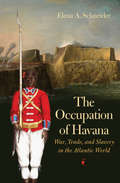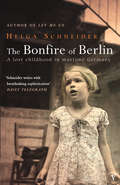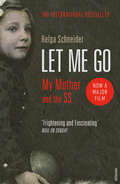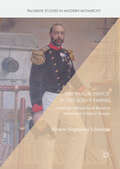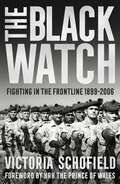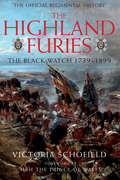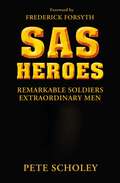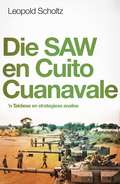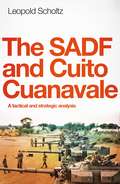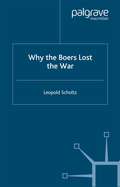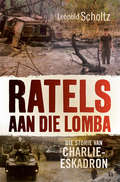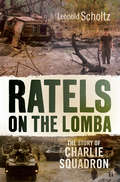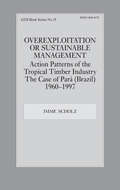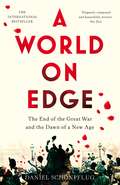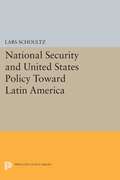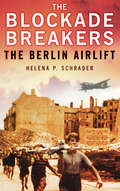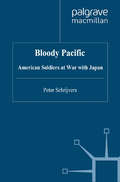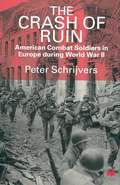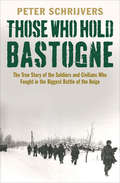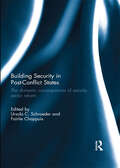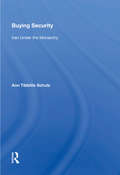- Table View
- List View
The Occupation of Havana: War, Trade, and Slavery in the Atlantic World (Published by the Omohundro Institute of Early American History and Culture and the University of North Carolina Press)
by Elena A. SchneiderIn 1762, British forces mobilized more than 230 ships and 26,000 soldiers, sailors, and enslaved Africans to attack Havana, one of the wealthiest and most populous ports in the Americas. They met fierce resistance. Spanish soldiers and local militias in Cuba, along with enslaved Africans who were promised freedom, held off the enemy for six suspenseful weeks. In the end, the British prevailed, but more lives were lost in the invasion and subsequent eleven-month British occupation of Havana than during the entire Seven Years' War in North America.The Occupation of Havana offers a nuanced and poignantly human account of the British capture and Spanish recovery of this coveted Caribbean city. The book explores both the interconnected histories of the British and Spanish empires and the crucial role played by free people of color and the enslaved in the creation and defense of Havana. Tragically, these men and women would watch their promise of freedom and greater rights vanish in the face of massive slave importation and increased sugar production upon Cuba's return to Spanish rule. By linking imperial negotiations with events in Cuba and their consequences, Elena Schneider sheds new light on the relationship between slavery and empire at the dawn of the Age of Revolutions.
The Bonfire Of Berlin: A Lost Childhood In Wartime Germany
by Helga SchneiderAbandoned by her mother, who left to pursue a career as a camp guard at Auschwitz-Birkenau, loathed by her step-mother, cooped up in a cellar, starved, parched, lonely amidst the fetid crush of her neighbours, Helga Schneider endured the horrors of wartime Berlin. The Bonfire of Berlin is a searing account of her survival. The grinding misery of hunger, combined with the terror of air-raids, the absence of fresh water and the constant threat of death and disease served not to unite the tenants and neighbours of her apartment block but rather to intensify the minor irritations of communal life into flashpoints of rage and violence. And with Russian victory the survivors could not look forward a return to peacetime but rather to pillage and rape. It was only gradually that Schneider's life returned to some kind of normality, as her beloved father returned from the front, carrying his own scars of the war. This shocking book evokes the reality of life in a wartime city in all its brutality and deprivation, while retaining a kernel of hope that while life remains not all is lost.
Let Me Go: My Mother And The Ss
by Helga SchneiderWhen Helga Schneider was four, her mother, Traudi, abandoned her to pursue her career. In 1998, Helga received a letter asking her to visit Traudi, now 90-years old, before she dies. Mother and daughter have met only once after Traudi left, on a disastrous visit where Helga first learnt the terrible secret of her mother's past. Traudi was as an extermination guard in Auschwitz and Ravensbruck and was involved in Nazi 'medical' experiments on prisoners. She has never expressed even the slightest remorse for her actions, yet Helga still hopes that at this final meeting she will find some way to forgive her mother.
The 'Sailor Prince' in the Age of Empire: Creating a Monarchical Brand in Nineteenth-Century Europe (Palgrave Studies in Modern Monarchy)
by Miriam Magdalena SchneiderThis book explores the puzzling phenomenon of the remarkable revival of monarchy in nineteenth-century Europe through a new prism: the public persona of the ‘Sailor Prince’. It highlights how four usually overlooked dynastic figures – the younger sons and brothers of monarchs such as Queen Victoria or Emperor William II – decisively helped to advertise their respective dynasties in the fiercely contested political and popular mass market, by aligning them with one of the most myth-invested cultural presences and power-political symbols of the Age of Empire: the navy. The 'Sailor Prince' in the Age of Empire traces the unusual professional careers, the adventurous empire travels and the multifaceted public representations of Prince Alfred of Britain (1844-1900), Prince Heinrich of Prussia (1862-1929), Prince Valdemar of Denmark (1858-1939) and Prince Georgios of Greece (1869-1957). Through the prism of these four personality brands, the study also investigates issues such as the role of the maritime sphere in national identity, the nature and extent of nineteenth-century monarchical modernization, the relevance of intra- and inter-imperial royal diplomacy in the Age of High Imperialism, and the curious collaboration of middle-class opinion-makers and entrepreneurs with Europe’s monarchical establishment.
The Black Watch: Fighting in the Frontline 1899-2006
by Victoria SchofieldThe heroic and inspiring story of the fortunes of the Black Watch, whose soldiers have distinguished themselves in theatres of war across the world.Formed into a regiment in 1739 and named for the dark tartan of its soldiers' kilts, The Black Watch has fought in almost every major conflict of nation and empire between 1745 and the present, and has a reputation second to none. Following on from The Highland Furies, in which she traced the regiment's history to 1899, Victoria Schofield tells the story of The Black Watch in the 20th and 21st centuries. She tracks its fortunes through the 2nd South African War, two World Wars, the 'troubles' in N Ireland and the war in Iraq – up to The Black Watch's merger with five other regiments to form the Royal Regiment of Scotland in 2006.Drawing on diaries, letters and interviews, Victoria Schofield weaves the many strands of the story into an epic narrative of a heroic body of officers and men. In her sure hands, the story of The Black Watch is no arid recitation of campaigns and battle honours, but a rewarding account of the fortunes of war of a regiment that has played a distinguished role in British, and world, history.
Highland Furies: The Black Watch 1739-1899
by Victoria SchofieldAs the oldest of the Highland Regiments, The Black Watch has an enviable roster of Battle Honours and a mystique born of repeated service on behalf of King, Queen and country. On the strength of her acclaimed biography of Field Marshal Earl Wavell, the regimental trustees commissioned Victoria Schofield to write this, the first volume of her magisterial history of the The Black Watch, and have fully cooperated with her as she traces the story of the Regiment from its early 18th-century beginnings through to the eve of the South African War at the end of the 19th-century. Originating as companies of highland men raised to keep a 'watch' over the Highlands of Scotland, they were formed into a regiment in 1739. Its soldiers would go on to fight with extraordinary bravery and élan in almost every major engagement fought by the British Army during this period, from the American War of Independence, the Peninsular Wars, Waterloo, the Crimea, Indian Mutiny to Egypt and the Sudan. Drawing on diaries, letters and memoirs, Victoria Schofield skilfully weaves the multiple strands of this story into an epic narrative of a valiant body of officers and men over one-and-a-half centuries. In her sure hands, the story of The Black Watch is no arid recitation of campaigns, dates and battle honours, but is instead a rich and compelling record of the soldier's experience under fire and on campaign. It is also a celebration of the deeds of a regiment that has played a unique role in British history and a vivid insight into the lives of the many remarkable figures who have marched and fought so proudly under its Colours.
SAS Heroes: Remarkable Soldiers, Extraordinary Men (General Military Ser.)
by Pete ScholeySAS Heroes contains former SAS member Pete Scholey's memories of 20 soldiers who were genuine heroes, although many were never recognised as such during their lives or even in death. It is a book of stories about soldiers who fought for their country with no desire to be famous, feted or rewarded, many of whom died in action. A few received medals, and all earned the respect and admiration of their fellow soldiers, their names and faces etched into the true history of the SAS. Some of the stories of Pete's heroes have never been told before and certainly none of the tales of combat and life in the regiment have been told in such a touching, real and compelling manner.
SAS Heroes: Remarkable Soldiers, Extraordinary Men
by Pete Scholey Frederick ForsythSAS Heroes contains former SAS member Pete Scholey's memories of 20 soldiers who were genuine heroes, although many were never recognised as such during their lives or even in death. It is a book of stories about soldiers who fought for their country with no desire to be famous, feted or rewarded, many of whom died in action. A few received medals, and all earned the respect and admiration of their fellow soldiers, their names and faces etched into the true history of the SAS. Some of the stories of Pete's heroes have never been told before and certainly none of the tales of combat and life in the regiment have been told in such a touching, real and compelling manner.
Die SAW en Cuito Cuanaval: ’n Taktiese en strategiese analise
by Dr Leopold ScholtzIn 1987–1988 was die stowwerige Angolese dorpie Cuito Cuanavale die toneel van die laaste gevegte van die Grensoorlog. Sedertdien is dit die fokuspunt van ’n openbare debat oor wie eintlik hierdie oorlog gewen het.Die leierskorps van die Suid-Afrikaanse Weermag (SAW) hou vol hulle is nooit verslaan nie, terwyl die alliansie van die Angolese MPLA-regering, Kuba en Swapo beweer hulle het die SAW uit Angola en Suidwes-Afrika verdryf. Hulle glo voorts die SAW wou Cuito Cuanavale beset en as afspringplek gebruik om Luanda in te neem.Maar was Cuito Cuanavale ooit regtig ’n doelwit vir die Suid-Afrikaners? Dit is die vraag wat Leopold Scholtz vra wanneer hy onlangs gedeklassi-fiseerde dokumente in die weermagargief bestudeer en die taktiese en strategiese besluite ondersoek wat ’n bepalende rol in die ses groot veldslae van dié veldtog gespeel het.Sy kritiese ontleding wys hoe maklik propaganda en politiek in die pad van feite kan staan.
The SADF and Cuito Cuanavale: A Tactical and Strategic Analysis
by Dr Leopold Scholtz“A shooting war is often followed by a second war. This war is not fought with bullets or artillery shells, not with tanks or bombers, but rather with words. The war is, in effect, fought again on paper.”In 1987–1988 the dusty Angolan town of Cuito Cuanavale was the backdrop for the final battles of the Border War. Ever since the war ended, the fighting around Cuito has been the subject of a fierce public debate over who actually won the war.While the leadership of the former South African Defence Force (SADF) claims it was never defeated, the supporters of the Angolan MPLA government, Cuba and SWAPO insist that the SADF was vanquished on the battlefield. They contend that the SADF wanted to overrun Cuito Cuanavale and use it as a springboard for an advance on Luanda.But was Cuito Cuanavale ever really an objective of the SADF? Leopold Scholtz tackles this question by examining recently declassified documents in the SANDF archives, exploring the strategic and tactical decisions that shaped the six main battles, from the SADF’s stunning tactical success on the Lomba River to the grinding struggle for the Tumpo Triangle.His incisive analysis untangles what happens when war, politics and propaganda become entwined.
Why the Boers Lost the War
by L. ScholtzWhy did the British win the Anglo-Boer War? Although there is truth in the simple statement that they were much stronger than the Boers, it does not explain everything. Therefore, the main focus of this book is to analyse the most important strategic and operational decisions made on both sides, and to measure them according to accepted modern military theory. It is shown that both the British and Boer war efforts were very haphazard at the beginning, but that both learnt as the war went on. In the end, the British got the Boers in a vice from which they could not escape.
Ratels aan die Lomba: Die storie van Charlie-eskadron
by Leopold ScholtzOp 3 Oktober 1987 het Charlie-eskadron - die ystervuis van 61 Gemeganiseerde Bataljongroep - op die Lombarivier in die suide van Angola teen 'n veel groter Angolese mag met beter wapentuig as hulle te staan gekom. Tenks is veronderstel teen tenks aangewend moes word. Tog moes die jong dienspligtiges die Angolese tenks van 47 Brigade in Ratels met minder kragtige kanonne en dun pantser aanvat. Boonop was die terrein so dig bebos dat hulle net enkele meter ver kon sien en moeilik kon beweeg.Leopold Scholtz se beskrywing van hierdie Dawid teen Goliat-geveg tydens Operasie Moduler neem die leser na die hart van die aksie. Danksy onderhoude met veterane en dagboekinskrywings dra hierdie intense hervertelling die volle drama van die geveg en ander ervarings aan die front oor. Dit is 'n diep menslike verhaal oor hoe individue reageer in die aangesig van die dood en ook hoe die oorlog hulle nooit uit sy kloue gelaat het nie...
Ratels on the Lomba: The story of Charlie Squadron
by Leopold ScholtzOn 3 October 1987 Charlie Squadron - the iron fist of 61 Mechanised Battalion Group - led the way in a decisive battle on the Lomba River in southern Angola, as part of the South African Defence Force's Operation Moduler. Although SADF tactical doctrine dictated that the tanks of the Angolan 47 Brigade be countered with tanks, the young conscripts of Charlie Squadron were forced to face their enemy in vastly inferior Ratels, significantly handicapped by the vehicles' thin armour and low-velocity guns. Not only were they facing a force far superior in terms of weaponry, but they were also hugely outnumbered and had to deal with terrain so dense that their sight was severely impaired and their movement restricted.Through interviews with veterans of the battle and diary entries from the time, Leopold Scholtz recreates the drama of this David vs Goliath battle, taking the reader straight to the heart of the action. A deeply human story, Ratels on the Lomba tells of how individuals react in the face of death, and reveals how the war never left these men, not even when they returned home.
Overexploitation or Sustainable Management? Action Patterns of the Tropical Timber Industry: The Case of Para (Brazil) 1960-1997
by Imme ScholzThe part played by the Brazilian tropical timber industry in deforesting the Amazon region has not been studied very much. This book describes the expansion of the timber industry in the Brazilian federal state of Para since the 1960s, when Amazon development became an important item on the government's agenda.
Overexploitation or Sustainable Management? Action Patterns of the Tropical Timber Industry: The Case of Para (Brazil) 1960-1997
by Imme ScholzThe part played by the Brazilian tropical timber industry in deforesting the Amazon region has not been studied very much. This book describes the expansion of the timber industry in the Brazilian federal state of Para since the 1960s, when Amazon development became an important item on the government's agenda.
A World on Edge: The End of the Great War and the Dawn of a New Age
by Daniel SchönpflugA World on Edge reveals Europe in 1918, left in ruins by World War I. With the end of hostilities, a radical new start seems not only possible, but essential, even unavoidable. Unorthodox ideas light up the age like the comets that have recently passed overhead: new politics, new societies, new art and culture, new thinking. The struggle to determine the future has begun.The sculptor Käthe Kollwitz, whose son died in the war, was translating sorrow and loss into art. Ho Chi Minh was working as a dishwasher in Paris and dreaming of liberating Vietnam, his homeland. Captain Harry S. Truman was running a men’s haberdashery in Kansas City, hardly expecting that he was about to go bankrupt – and later become president of the United States. Professor Moina Michael was about to invent the 'remembrance poppy', a symbol of sacrifice that will stand for generations to come. Meanwhile Virginia Woolf had just published her first book and was questioning whether that sacrifice was worth it, while the artist George Grosz was so revolted by the violence on the streets of Berlin that he decides everything is meaningless. For rulers and revolutionaries, a world of power and privilege was dying – while for others, a dream of overthrowing democracy was being born.With novelistic virtuosity, historian Daniel Schönpflug describes this watershed year as it was experienced on the ground – open ended, unfathomable, its outcome unclear. Told from the vantage points of people, famous and ordinary, good and evil, who lived through the turmoil and combining a multitude of acutely observed details, Schönpflug composes a brilliantly conceived panorama of a world suspended between enthusiasm and disappointment, and of a moment in which the window of opportunity was suddenly open, only to quickly close shut once again.
National Security and United States Policy Toward Latin America
by Lars SchoultzLars Schoultz proposes a way for all those interested in U.S. foreign policy fully to appreciate the terms of the present debate. To understand U.S. policy in Latin America, he contends, one must critically examine the deeply held beliefs of U.S. policy makers about what Latin America means to U.S. national security.Originally published in 1987.The Princeton Legacy Library uses the latest print-on-demand technology to again make available previously out-of-print books from the distinguished backlist of Princeton University Press. These editions preserve the original texts of these important books while presenting them in durable paperback and hardcover editions. The goal of the Princeton Legacy Library is to vastly increase access to the rich scholarly heritage found in the thousands of books published by Princeton University Press since its founding in 1905.
The Blockade Breakers: The Berlin Airlift
by Helena P SchraderOn 24 June 1948 the Sovient Union abrubtly closed all land and water access to the Western Sectors of Berlin. Over 2 million civilians, dependent on the surrounding territory and the West for food, fuel, and other basic goods, were suddenly cut off from all necessities of life. The Western Allies had the option of withdrawing their garrisons and allowing the Soviet Union to take control of the entire city, or of trying to supply the city by air. Never in history had 2 million people been supplied exclusively by air before. None of the senior military commanders believed it could be done. But the political leadership in London and Washington insisted that it must be done. A withdrawal from Berlin would discredit the West at a critical moment in history, when the Soviet Union was expanding aggressively across Europe. Worse, it would endanger the political stability and economic recovery of all of Europe. So the largest and most ambition Airlift in history was set in motion. It began without the West really knowing what the Berliners needed in order to survive - much less how much those supplies weighed. It was launched despite a lack of airlift expertise in theatre or a unified command structure, an almost complete absence of aircraft and aircrew resources in Germany and serious inadequacies in airfields and air traffic control. But once it took wing, it flew and turned into something that not even its originators and advocators had ever imagined or expected.
Bloody Pacific: American Soldiers at War with Japan
by P. SchrijversBased on countless diaries and letters, Schrijvers recounts American GIs' experiences in Asia and the Pacific. From the daunting spaces of the China-India theatre to the fortress islands of Iwo Jima and Okinawa, he brings to life their struggle with suffocating wilderness, devastating diseases, and Japanese soldiers who preferred death over life.
The GI War Against Japan: American Soldiers in Asia and the Pacific During World War II
by P. SchrijversBased on numerous diaries and letters, this book depicts the story of America's soldier sin Asia and the Pacific during World War II. Combining social and cultural history, the author examines the GIs' encounters with Asia's environmental, sociocultural and racial otherness and the impact that these encounters had on them. The Americans' experience in Asia and the Pacific presaged the devastation of Hiroshima and Nagasaki.
The Crash of Ruin: American Combat Soldiers in Europe during World War II
by Peter SchrijversThis book offers a compelling account of how America's combat soldiers experienced Europe during World War II. It paints a vivid picture of the GIs' struggles with its natural surroundings, their confrontations with its soldiers, their encounters with its civilians, and their reactions to uncovering the holocaust. The book shows how these harrowing experiences convinced the American soldiers that Europe's collapse was not just the result of the war, but also of the Old World's deep-seated political cynicism, economic stagnation, and cultural decadence.
Those Who Hold Bastogne: The True Story of the Soldiers and Civilians Who Fought in the Biggest Battle of the Bulge
by Peter SchrijversHitler’s last gamble, the Battle of the Bulge, was intended to push the Allied invaders of Normandy all the way back to the beaches. The plan nearly succeeded, and almost certainly would have, were it not for one small Belgian town and its tenacious American defenders who held back a tenfold larger German force while awaiting the arrival of General George Patton’s mighty Third Army. In this dramatic account of the 1944–45 winter of war in Bastogne, historian Peter Schrijvers offers the first full story of the German assault on the strategically located town. From the December stampede of American and Panzer divisions racing to reach Bastogne first, through the bloody eight-day siege from land and air, and through three more weeks of unrelenting fighting even after the siege was broken, events at Bastogne hastened the long-awaited end of WWII. Schrijvers draws on diaries, memoirs, and other fresh sources to illuminate the experiences not only of Bastogne’s 3,000 citizens and their American defenders, but also of German soldiers and commanders desperate for victory. The costs of war are here made real, uncovered in the stories of those who perished and those who emerged from battle to find the world forever changed.
Building Security in Post-Conflict States: The Domestic Consequences of Security Sector Reform
by Ursula SchroederSupport for security and justice institutions has become a crucial instrument of international engagement in fragile and conflict-affected states. In attempts to shore up security as a precondition for sustainable peace, international actors have become deeply engaged in reforming the security agencies and security governance institutions of states emerging from conflict. But despite their increasing importance in the field of international peace- and state-building, security sector reform (SSR) interventions remain both highly political and deeply contentious processes. Expanding on this theme, this edited volume identifies new directions in research on the domestic consequences of external support to security sector reform. Both empirically and theoretically, the focus lies on the so far neglected role of domestic actors, interests and political power constellations in recipient states. Based on a wide range of empirical cases, the volume discusses how the often conflictual and asymmetric encounters between external and domestic actors with divergent interests and perceptions affect the consequences of international interventions. By taking into account the plurality of state and non-state security actors and institutions beyond classical models of Weberian statehood, the contributions make the case for engaging more closely with the complexity of the domestic security governance configurations that can result from external engagement in the field of security sector reform.This book was published as a special issue of International Peacekeeping.
Buying Security: Iran Under The Monarchy
by Ann Tibbitts SchulzThis book looks at trends in military expenditures in Iran during, approximately, the three decades preceding the Islamic revolution of 1979 and their impact on economic growth and development. It focuses on military security policy, which establishes guidelines for military spending decisions.
Buying Security: Iran Under The Monarchy
by Ann Tibbitts SchulzThis book looks at trends in military expenditures in Iran during, approximately, the three decades preceding the Islamic revolution of 1979 and their impact on economic growth and development. It focuses on military security policy, which establishes guidelines for military spending decisions.
